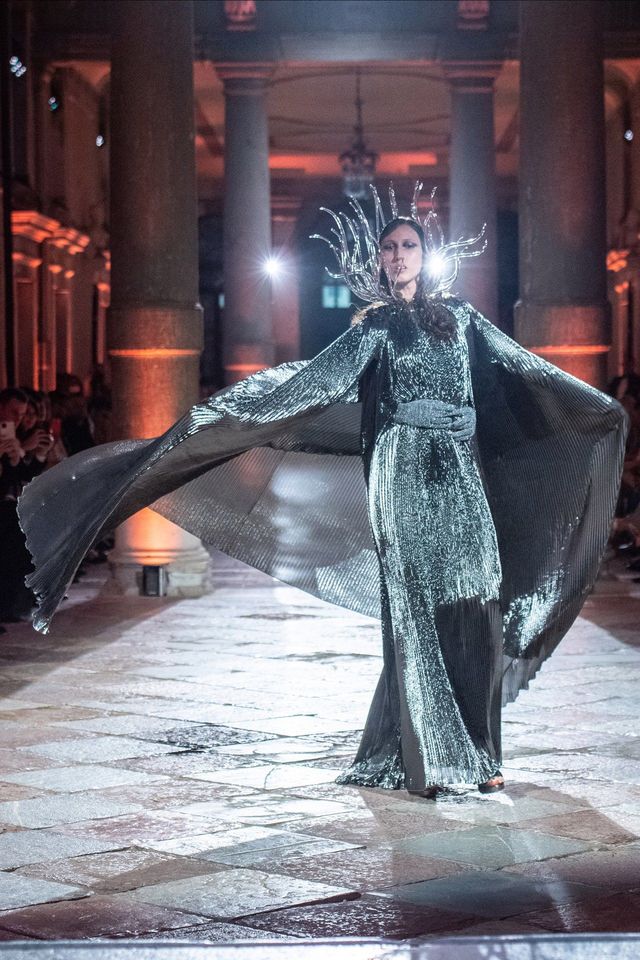The past 18 months have been dark days for Venice. As a city whose economy-and perhaps more importantly, spirit-depend on tourism, seeing its cobbled streets empty during the typical boom months of spring and summer have felt, by all accounts from those who lived through it, surreal. As the annual circus of the Venice Film Festival descended last week, however, the city appeared to have been kickstarted back to life with the utmost grandeur. But alongside the newly rolled out red carpets, and the stars who walked down them in dazzling couture gowns, a smaller and more studied sartorial tribute to the city and its return to normal life took place in a more unexpected venue on Saturday night, courtesy of Alberta Ferretti.
In the monumental entrance hall of Ca’ Rezzonico, a Baroque palace that today serves as a museum dedicated to the city’s hedonistic settecento culture-think gluttony, gambling, and lavishly dressed Grand Tourists-an audience mostly consisting of the brand’s community and clients sat as dusk fell over the Grand Canal to watch the spectacle unfold. As the joyous, leaping strings of Max Richter’s “recompositions” of Vivaldi’s The Four Seasons echoed around the hall, 27 of Ferretti’s signature romantic gowns glided down the cavernous, candlelit entryway, each more opulent than the last. Yet while there were plenty of references to the city’s rich iconography-most notably in a sheer silk top embroidered with the lion of St. Mark in glittering gold-the nods to the city’s spirit and cultural heritage were elsewhere woven in more loosely.
“I didn’t want to make a collection that felt too didactic or literal,” said Ferretti before the show. “I looked at the Venice of today to create something that felt contemporary, but crafted with the traditions of the local masters, because there are so many artisans making beautiful creations working here still.” This philosophy also extended to her decision not to stage the show within the grand trappings of the building’s piano nobile, the high-ceilinged first floor ballroom covered with Tiepolo frescoes where the city’s debauched Carnevale parties would have typically taken place. “I liked the idea of the entrance hall as something so imposing and austere to show these clothes, as they arrive to head up the staircase to this imagined party,” Ferretti added. “But you don’t see what happens when they get to the party.”
These were clearly clothes to make an entrance in. Staged as part of the Municipality of Venice’s ongoing celebrations this year to honor the 1,600th anniversary of the city’s founding, Ferretti’s Serenissima spectacle carried echoes of her fall 2017 collection, which offered Milan Fashion Week showgoers that season a brief diversion to a world of Carnevale cloaks and Canaletto-inspired prints. This time, however, Ferretti looked to Venice’s rich culture of artisanal craftsmanship. Marbled silk damasks echoed the traditional designs of the Rubelli and Bevilacqua textile houses, while sunray pleated skirts and capes in shimmering metallic were a playful nod to the work of Mariano Fortuny, whose palazzo still serves one of the city’s most breathtaking museums. A collaboration with Massimiliano Schiavon, a sixth-generation glassblower based on Murano, saw the creation of dramatic necklaces that sprouted with gorgeously sinuous, tentacle-esque forms like creatures that emerged deep from the lagoon.
Despite having grown up in the province of Rimini and today being based firmly in Milan, for Ferretti, being invited to stage the show by the Municipality of Venice was something she described as “an honor.” “I still remember the first time I came to Venice as a child,” she said. “I immediately fell in love. I was truly, truly moved.” While there are few cities in the world better aligned with Ferretti’s eye for romance than Venice, it was also a means of giving back, too, with half of the looks to be donated to the city’s Museo di Palazzo Mocenigo, which houses the civic collection of textiles and costume. (With their richly embellished surfaces and billowing silhouettes, Ferretti’s pieces certainly won’t look out of place among the historical dress of the Doges and noblemen of centuries past.)
That the event took place during the thick of the Venice Film Festival was also no accident. Yesterday, Ferretti received a Women in Cinema award at the Hotel Excelsior for her work in the film industry, with the organizers citing both her role as a regular red carpet favorite for some of Hollywood’s greatest stars, and her involvement in crafting a dress for Sandra Bullock’s character in Ocean’s 8. For Ferretti, the award holds a special significance given her life-long passion for film. She noted that she grew up immersed in the work of Federico Fellini, who was born just half an hour away from her hometown of Cattolica in Rimini, and that the mutual learning process of working with actors has been one of the greatest joys of her career. “I am a dreamer, and when I’m seeking inspiration, I picture these powerful actresses wearing the clothes,” said Ferretti. “Even planning a collection is a little bit like being a director of a movie, imagining and interpreting the costumes that the women in this movie are going to wear.”
If her show at Ca’ Rezzonico was a movie, then its star was Anna Cleveland, who closed the show in a dazzling silver pleated gown that could have come straight out of an Erté illustration, swishing and twirling her cape as she turned in circles down the grand entryway. The finishing touch? A pair of sculpted silver hands crossed around Cleveland’s waist, crafted by the Italian artist Lorenzo Quinn, whose large-scale sculpture “Support” of two hands propping up the historic Ca’ Sagredo on the Grand Canal served as one of the highlights of the city’s 2017 Biennale. As the models filed out into the palazzo’s courtyard and gardens at the end of the show to the dying strains of Vivaldi, so concluded a singular ode to the city’s enduring magic. As Ferretti put it: “Fantastico.”














